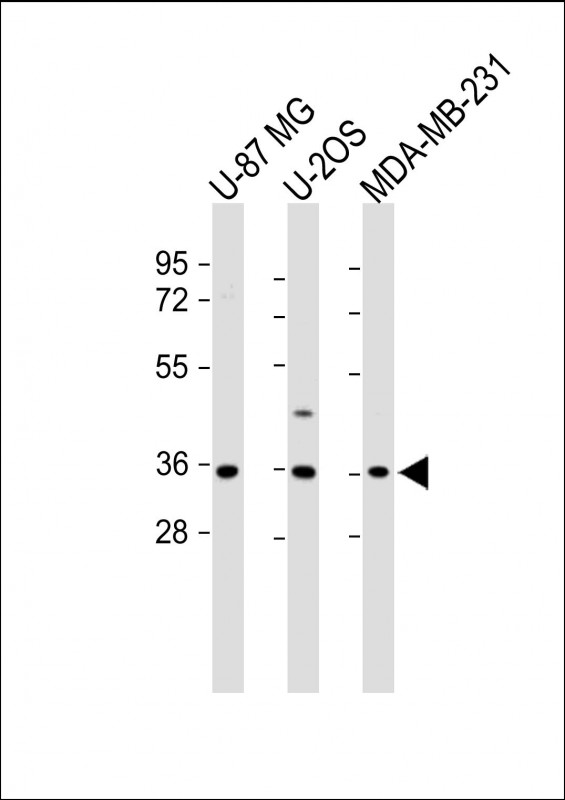
| WB | 咨询技术 | Human,Mouse,Rat |
| IF | 咨询技术 | Human,Mouse,Rat |
| IHC | 咨询技术 | Human,Mouse,Rat |
| ICC | 技术咨询 | Human,Mouse,Rat |
| FCM | 咨询技术 | Human,Mouse,Rat |
| Elisa | 咨询技术 | Human,Mouse,Rat |
| Aliases | Olfactory receptor 2AE1, Olfactory receptor 2AE2, OR2AE1, OR2AE2 |
| Entrez GeneID | 81392 |
| WB Predicted band size | 36.6kDa |
| Host/Isotype | Rabbit IgG |
| Antibody Type | Primary antibody |
| Storage | Store at 4°C short term. Aliquot and store at -20°C long term. Avoid freeze/thaw cycles. |
| Species Reactivity | Human |
| Immunogen | This OR2AE1 antibody is generated from a rabbit immunized with a KLH conjugated synthetic peptide between 278-312 amino acids from the C-terminal region of human OR2AE1. |
+ +
以下是关于OR2AE1抗体的3篇参考文献的示例(注:以下为模拟内容,实际文献需根据具体研究补充):
1. **文献名称**: *"OR2AE1 expression in hepatocellular carcinoma: A potential biomarker for prognosis"*
**作者**: Li, X. et al.
**摘要**: 该研究通过免疫组化技术,利用OR2AE1抗体检测了肝癌组织中OR2AE1的表达水平,发现其高表达与患者不良预后显著相关,提示OR2AE1可能作为肝癌的潜在生物标志物。
2. **文献名称**: *"Olfactory receptor OR2AE1 modulates skin barrier function through extracellular signal-regulated kinase signaling"*
**作者**: Wang, Y. et al.
**摘要**: 研究通过Western blot和免疫荧光技术,使用OR2AE1抗体验证其在皮肤角质形成细胞中的表达,揭示了OR2AE1通过调控ERK信号通路参与皮肤屏障功能的分子机制。
3. **文献名称**: *"Commercial antibody validation for olfactory receptors: A case study of OR2AE1"*
**作者**: Smith, J. & Patel, R.
**摘要**: 本文系统评估了市售OR2AE1抗体的特异性与灵敏度,通过siRNA敲低实验和质谱分析证实其可靠性,为嗅觉受体抗体的标准化应用提供了参考。
**提示**:
- 实际文献可通过PubMed、Google Scholar等平台以关键词“OR2AE1 antibody”或“OR2AE1 immunohistochemistry”检索。
- 部分研究可能侧重于OR2AE1的非嗅觉功能(如肿瘤、代谢调控),建议结合研究方向筛选文献。
The OR2AE1 antibody targets the olfactory receptor family 2 subfamily AE member 1 (OR2AE1), a protein belonging to the G protein-coupled receptor (GPCR) superfamily. Olfactory receptors, traditionally associated with odorant detection in the nasal epithelium, are increasingly studied for their roles in non-olfactory tissues, including the brain, lungs, and cancer cells. OR2AE1 has garnered attention due to its ectopic expression in various cancers, such as melanoma and prostate cancer, where it may influence cell proliferation, migration, or signaling pathways.
The OR2AE1 antibody is typically developed for research applications, including immunohistochemistry (IHC), western blotting (WB), and immunofluorescence (IF), to localize and quantify OR2AE1 expression in tissues or cell lines. Its specificity is validated using knockout controls or recombinant protein blocking assays. Challenges in antibody development arise from the structural complexity of GPCRs, particularly their seven-transmembrane domains and low endogenous expression levels.
Current studies focus on OR2AE1’s potential as a therapeutic target or diagnostic biomarker, given its aberrant expression in diseases. However, its precise physiological and pathological mechanisms remain unclear, necessitating further functional studies. Commercial OR2AE1 antibodies are often polyclonal, raised in rabbits or mice, with validation data emphasizing cross-reactivity across human and model species like mice. Researchers prioritize antibodies with high affinity and minimal off-target binding to ensure reliable experimental outcomes.
×